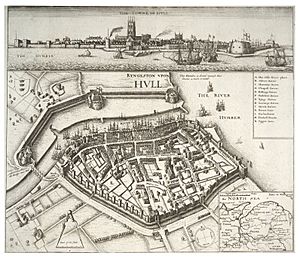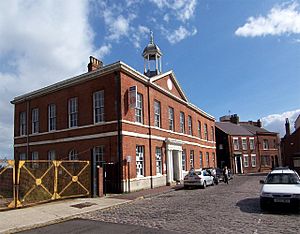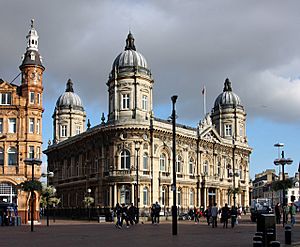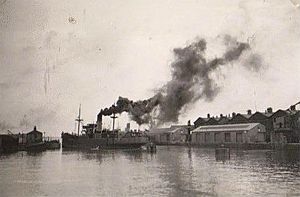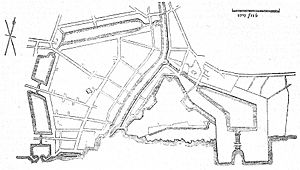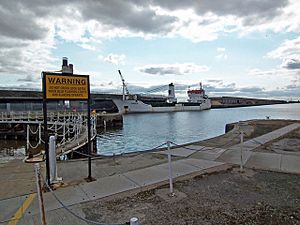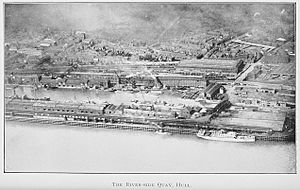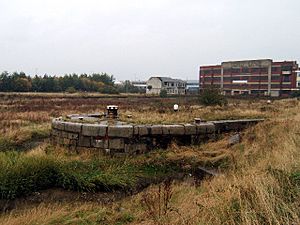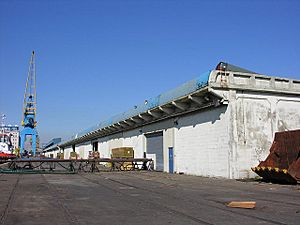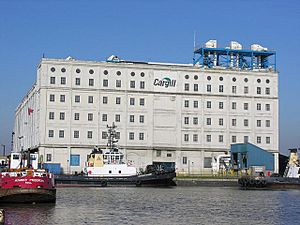Port of Hull facts for kids
Quick facts for kids Port of Hull |
|
|---|---|
 |
|
| Location | |
| Country | England |
| Location | Kingston upon Hull |
| Coordinates | 53°44′17″N 0°19′55″W / 53.738°N 0.332°W |
| Details | |
| Operated by | Associated British Ports |
The Port of Hull is a busy port where the River Hull meets the Humber Estuary in Kingston upon Hull, England. It's a really old port, with ships trading here since at least the 1200s!
Back in 1773, a company called the Hull Dock Company was created. They built Hull's first dock on land where the old Hull town walls used to be. Over the next 50 years, more docks were built around the Old Town. These were known as the Town Docks. The first was The Dock (1778), later called Queen's Dock. Then came Humber Dock (1809) and Junction Dock (1829). A bit later, Railway Dock (1846) was added to help with the new Hull and Selby Railway.
In 1850, Victoria Dock opened east of the River Hull. More docks were built along the Humber to the west, starting with West Dock (later Albert Dock) in 1862. William Wright Dock opened in 1880, and St Andrew's Dock in 1883. In 1885, Alexandra Dock was built by a different railway company. Later, in 1914, King George Dock was built by two railway companies working together. It was extended in 1969 and named Queen Elizabeth Dock.
Today, Alexandra Dock is being updated for building wind farms. This project is called Green Port Hull. Many older docks, like the Town Docks, Victoria Dock, and St Andrew's Dock, closed by the 1970s. Some were filled in and rebuilt. Humber and Railway docks are now part of Hull Marina, used for leisure boats.
Other important parts of the port included Riverside Quay, used for passenger ferries, and Corporation Pier, where a ferry sailed to New Holland, Lincolnshire. The River Hull also had many industrial businesses and dry docks. East of Hull, Salt End became a big place for oil in the 1900s, and later for chemical factories.
As of 2023, Associated British Ports runs the main port. It handles about one million passengers each year. It's also the main place in the UK for importing softwood timber.
Contents
History of Hull's Port
Early Beginnings
Hull is in a great spot for a port on the north side of the Humber Estuary. The River Hull flows into the Humber right there. Before 1200, a monastery called Meaux Abbey started using the port to export wool.
A big moment for Hull's port was when King Edward I took it over in 1297. It became the only port in Yorkshire allowed to export goods overseas. So, in the 1200s and 1300s, Hull was a major English port for sending out wool to places like Flanders. Wine was a big import. During this time, the River Hull was made easy to travel on for ships up to Beverley (1269). Roads were also built to connect Hull to Beverley and other areas.
By the 1400s, trading with the Hanseatic league became important. As England's cloth industry grew, Hull exported more cloth and less wool. In the 1500s, cloth trade went down, but lead exports went up. By the late 1600s, Hull was the third most important port in England, after London and Bristol. It exported lead and cloth, and imported things like flax, hemp, iron, and tar from the Baltic Sea.
Until 1773, ships used the Old Harbour, also called The Haven. This was a series of wharves (docking areas) on the west side of the River Hull.
The Hull Dock Company
By the 1700s, the Haven was getting too crowded for all the ships. It was also narrow, affected by tides, and often filled with mud. Customs officials also wanted a "legal quay" where they could easily check goods.
In 1773, the Hull Corporation, Hull Trinity House, and local merchants formed the Hull Dock Company. This was the first company in Britain created by law to build docks. The King gave them land where Hull's city walls used to be. In 1774, a law was passed, allowing the company to raise money. Hull's first dock, the Old Dock, started being built.
The company built three docks, known as the Town Docks, between 1778 and 1829. These followed the path of the old city walls. They were The Old Dock (later Queen's Dock, 1778), Humber Dock (1809), and Junction Dock (later Prince's Dock, 1829). An extra dock, Railway Dock, was built in 1846 for the new Hull and Selby Railway. The first dock east of the River Hull, Victoria Dock, was built between 1845 and 1850. It became the main dock for timber.
In 1860, a rival company, the West Dock Company, was formed. They wanted to build new docks for bigger ships and more trade. The Hull Dock Company then suggested an even bigger dock in the same spot. This was approved in 1861 and became Albert Dock in 1869. An extension, William Wright Dock, opened in 1880. A third dock, St Andrew's Dock, opened in 1883. These docks were great for moving goods by train.
In 1885, Alexandra Dock opened. It was owned by a different company, which meant the Hull Dock Company no longer had a monopoly (total control) on docks in Hull. This led to a price war between the two companies. The Hull Dock Company eventually joined with the North Eastern Railway (NER) in 1893.
Because of this merger, the NER and the Hull and Barnsley Railway (H&BR) worked together to build a new dock east of Alexandra Dock. This new dock, called the King George Dock, opened in 1914.
Dock Ownership Changes
In 1922, the Hull and Barnsley Railway joined the North Eastern Railway. This meant all the docks in Hull were run by one company again. Then, in 1923, the NER became part of the London and North Eastern Railway. In 1948, the British government took over many transport companies, including the port and railways. In 1962, the British Transport Docks Board was created. Finally, in 1981, the company became private again and was named Associated British Ports.
On November 23, 1981, a weak tornado hit the docks. Later that day, a stronger tornado hit Hull's northern suburbs.
Hull's Docks
The Town Docks
The Old Dock (Queen's Dock)
By the mid-1700s, the River Hull was so crowded with ships that they were getting damaged. There were also delays in moving goods. So, people started looking into building new docks. Customs officials also wanted a special "legal quay" to inspect goods easily.
In 1773, the Hull Corporation and Customs agreed to build a new dock. The Old Dock, Hull's first dock, was built between 1775 and 1778. It was about 1,703 feet long and 254 feet wide. The entrance was on the River Hull.
Some parts of the dock walls had problems during construction and needed to be rebuilt. Despite these issues, the dock officially opened on September 22, 1778. The lock and basin were rebuilt in 1814-1815.
The dock was first called The Dock, then The Old Dock. In 1855, it was officially named Queen's Dock.
The dock closed in 1930 and was sold to the city. It was then filled in and turned into beautiful gardens called Queen's Gardens.
Humber Dock
Since the Old Dock's entrance was on the crowded River Hull, ships still had trouble getting in. In 1781, people suggested building a canal to connect the Old Dock to the Humber. Trade continued to grow.
In 1802, a law was passed to build a second dock. This dock, Humber Dock, also followed the path of the old city walls. It was designed by John Rennie and William Chapman. Construction started in 1803 and finished in 1809, costing £220,000.
The dock was 914 feet long and 342 feet wide. It had an entrance from the Humber through an outer basin. A swing bridge crossed the lock.
Humber Dock closed in 1968. It reopened in 1983 as the Hull Marina, a place for leisure boats. The dock, its lock, and the swing bridge are now protected historical structures.
Junction Dock (Prince's Dock)
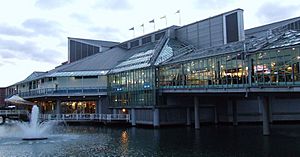
A rule from the 1802 law said that the Dock Company had to build a third dock when trade reached a certain level. This happened in 1825. So, construction of Junction Dock began in 1826.
This dock was built between and connected to the Old and Humber Docks. This made the old town of Hull an island, surrounded by the three docks, the river, and the estuary.
It was designed by James Walker and cost £186,000. The dock opened in 1829. It was 645 feet long and 407 feet wide, with a lock and a bridge at each end. In 1855, it was renamed Prince's Dock after a visit from Queen Victoria and Albert, Prince Consort.
The dock closed in 1968. Part of it still exists, but it's no longer connected to Humber Dock. The Princes Quay shopping centre, which opened in 1991, was built on stilts over part of the dock. The dock now has a fountain.
Railway Dock
The Dock Company got permission to build a new branch dock in 1844. The Railway Dock was connected to the west side of Humber Dock. It was smaller than the other town docks, about 716 by 165 feet, and cost £106,000. It opened on December 3, 1846.
Its main purpose was to transfer goods to and from the new Hull and Selby Railway. Railway lines also ran from the goods sheds to Humber Dock.
Like Humber Dock, Railway Dock closed in 1968 and became part of Hull Marina in 1984.
Victoria Dock
After Junction Dock was built in 1825, the port continued to grow, needing a new dock. In 1838, a company was formed to build a new dock called Queen's Dock. This dock was planned for an area east of the River Hull.
The Dock Company took over a similar plan. Construction of this new dock began in 1845 and finished in 1850, costing £300,000. It was formally opened on July 3, 1850, and named Victoria Dock in honor of Queen Victoria.
The dock covered about 12.83 acres. It had two entrances: a larger one onto the Humber and a smaller one onto the River Hull. It was mainly used for timber trade.
In 1863, the dock was expanded eastwards by 8 acres, and a second timber pond was added. The land where the Hull Citadel used to be was sold to the Dock company in 1864 and used for timber storage.
By the second half of the 1900s, both timber ponds had been filled in to create timber yards and railway sidings. The dock was also used for importing cattle and exporting coal.
Victoria Dock closed in the 1970s and was filled in. The land was used to build houses in the late 1980s.
The West Docks
Albert Dock
In 1860, the West Dock Company was formed to build a dock along the Humber in West Hull. The Hull Dock Company then proposed a rival plan, which was approved in 1861.
This new dock was built on the Humber foreshore. Construction began in October 1862. The dock was planned to be 3,350 feet long and cover 22.8 acres. The engineer was John Hawkshaw.
During construction, there were problems with the ground, including a wall bursting and water flooding in. Despite these difficulties, the dock was opened in 1869 by the Prince and Princess of Wales (Albert Edward, Prince of Wales, later Edward VII, and Alexandra, Princess of Wales). It was named Albert Dock.
Both Albert and William Wright docks stopped being used for large commercial ships in 1972. They were then used for fishing boats. Since 1975, Hull's fishing fleet has used these docks. As of 2010, they are still used for general cargo and the smaller Hull fishing industry.
In December 2013, a big storm surge from the North Sea caused flooding in Hull city centre. Water came over the Albert Dock walls and through the lock gates. Because of this, new flood defenses were built, including a 950-meter long wall that is 1 meter high. It was finished by November 2015.
William Wright Dock
While Albert Dock was still being built, the Dock Company got permission in 1866 and 1867 to extend it westwards.
Construction of William Wright Dock began in 1873. It was planned as an 8-acre extension of Albert Dock. The dock opened in 1880 and was named after William Wright, the chairman of the Dock Company. It was 5.75 acres in size.
The 2013 storm surge also damaged the north-western wall of this dock.
Riverside Quay
In 1904, the North Eastern Railway (NER), which owned most of Hull's docks, got permission to build a quay (a loading platform) along the Humber Estuary next to Albert Dock. This quay was designed for quickly handling food and other goods. It helped ships avoid waiting for locks or low tides.
The quay was 2,500 feet long and extended about 90 feet into the estuary. It had electric cranes and a water supply. It also included a passenger station for trains connecting to continental Europe.
The quay started being used in 1907. Ships sailed from here to Zeebrugge, Norway, and Rotterdam. It was fully finished by 1911.
During the Hull Blitz in World War II, the quay was destroyed by fires from enemy bombing in May 1941. In the 1950s, a new concrete quay was built and opened in 1959.
St Andrew's Dock
St Andrew's Dock was built at the same time as the Albert Dock extension. It opened in 1883, just west of William Wright Dock, and covered over 10.5 acres. Although it was meant for coal, it was used only for the fishing industry.
The dock was extended by about 10 acres starting in 1894. This included building slipways for boat repairs. During construction, a temporary dam burst, damaging many ships in the dock. This was thought to be caused by underground springs.
The dock was used until 1975, when the fishing industry moved to Albert Dock. St Andrew's Dock then closed. Parts of the dock were filled in during the 1980s. The western part is now a retail park called St Andrews Quay. The eastern part, around the entrance, is a protected historical area. The dock entrance and some old shipping buildings are still there, but the dock itself is completely filled with mud.
In 2013, a group chose a design for a memorial to the 6,000 Hull fishermen who died at sea. It will be placed next to the Humber at the dock.
Alexandra Dock
Alexandra Dock was built between 1881 and 1885 on land taken from the Humber. It was part of a big project by the Hull Barnsley & West Riding Junction Railway and Dock Company. The dock machinery, including lock gates, used hydraulic power.
The dock was built east of Victoria Dock, with an exit to the Humber. Water to fill the dock came from the Holderness Drain to reduce mud build-up. The dock covered 46.5 acres. Steam and hydraulic machines helped with construction.
The dock opened on July 16, 1885, and was named after Alexandra, Princess of Wales. It cost over £1.3 million.
The entrance lock was 550 feet long and 85 feet wide. Two dry docks were built at the north-east corner for ship repairs. The dock's main purpose was to export coal.
In 1899, the dock was expanded by 7 acres. A pier onto the Humber Estuary (West Wharf) was added in 1911.
Alexandra Dock closed in 1982, and its railway connection was removed. It reopened in 1991 without a rail link.
In the 1990s, parts of the port land were used for a marine terminal for sand and gravel. A concrete plant was also built.
Plans for a riverside container terminal, called Quay 2005, were approved in 2005. Construction was delayed, and the project was later changed to attract offshore wind power businesses.
As of 2010, Alexandra Dock handles goods like aggregates (crushed stone), farm products, chemicals, and wood. It also has a terminal for roll-on/roll-off (Ro-Ro) ships.
Green Port Hull
In January 2011, Siemens and Associated British Ports agreed to build a wind energy machine factory at Alexandra Dock. This site was chosen because it's close to planned large wind farms in the North Sea.
The project, called Green Port Hull, included using the Quay 2005 wharf for wind turbine logistics. It also involved filling in part of the dock west of the lock gates to create more land for the factory. The initial plan included a factory for nacelles (the top part of a wind turbine) and other storage areas.
The agreement was finalized in March 2014. ABP invested £150 million, and Siemens invested £160 million. The facility was expected to start working between 2016 and 2017. Construction began in January 2015. Revised plans in April 2015 focused on a blade manufacturing factory, along with storage for wind farm installation.
As part of the development, a famous piece of graffiti called "Dead Bod," painted by Captain Len Rood in the 1960s, was carefully removed and saved. It was a landmark for ships on the Humber. In early 2017, after being restored, "Dead Bod" was shown at the Humber Street Gallery as part of the City of Culture 2017 celebrations.
The blade factory officially opened on December 1, 2016. It is expected to operate for about 30 years.
In August 2021, Siemens announced a £186 million investment to double the size of the blade factory. This will allow it to make even larger blades, over 100 meters long. This expansion is expected to be finished by 2023.
Hull Joint Dock (King George and Queen Elizabeth Docks)
By the early 1890s, Hull needed more port facilities, especially for large coal ships and new steam trawlers. The NER and the Hull and Barnsley Railway (HBR) agreed to build a new dock together. This was approved by law in 1899.
Construction of the dock was delayed until 1906 and finished in 1914. The new dock was officially named the King George Dock. An extension to the south-east, sharing the same lock, opened in 1969 as the Queen Elizabeth Dock. In 1993, the dock got a terminal outside the lock gates on the Humber, called River Terminal 1, now known as Rotterdam Terminal.
King George Dock (1914–)
The two companies estimated the cost of the new dock at over £1.4 million in 1899. The initial plan was for a 60-acre dock, but this was reduced to 32 acres because of high construction costs.
Construction began in 1906. Much of the dock site was beyond the existing Humber bank, so land had to be reclaimed. The ground was weak, with quicksand, causing challenges during construction. The dock walls were made of concrete and granite.
When it opened in 1914, the dock had a water area of 53 acres. It had a central area and two main arms. The western arm had warehouses, and the northern quay had six berths for loading coal. The main lock was 750 feet long and 85 feet wide. The dock was designed to be expanded later.
Most of the dock equipment was powered by electricity, including coal conveyors, cranes, and lights. Hydraulic power was used for lock gates and coal tippers.
On June 26, 1914, King George V visited Hull and officially opened the Hull Joint Dock. It was then named King George Dock in his honor.
A large grain silo, holding 40,000 tons, was built at the end of the north-western quay and finished by 1919.
In 1959, a £4.75 million plan was approved to improve the dock. This included removing coal loading equipment, converting diagonal berths into straight ones, and adding new storage sheds and electric cranes.
In 1965, berths for roll-on/roll-off ferries were added, increasing the use of the dock for transporting goods in units.
Queen Elizabeth Dock Extension (1969–)
In 1968, work began on a 28-acre extension to King George Dock, built on reclaimed land to the south-east. This extension was officially opened in August 1969 by Queen Elizabeth II and named Queen Elizabeth Dock.
Recent History (1970–)
A container terminal opened in 1971 at Queen Elizabeth Dock. By 1975, there were six roll-on/roll-off terminals in the two docks.
In 1984, Anglia Oils (now AarhusKarlshamn) opened a factory at King George Dock that refines vegetable oil.
PD Ports started running the Hull Container Terminal in 1990. By the mid-2000s, it handled over 100,000 containers per year.
In 1993, River Terminal 1, a £12 million terminal for large roll-on/roll-off ships, opened on the Humber Estuary. A covered terminal for steel handling opened in 1997. It was renamed Hull All-Weather Terminal in 2009 and expanded to handle other weather-sensitive goods.
In 2001, new facilities were opened on the Humber banks. The Rotterdam Terminal, costing £14.3 million, was built for P&O North Sea Ferries' new ships, the Pride of Rotterdam and Pride of Hull, which sail the Hull-Rotterdam route.
The 1919 grain silo was taken down in 2010–11.
As of 2010, the two docks also had a large cold storage facility and passenger services to Zeebrugge. AarhusKarlshamn runs a big vegetable oil processing plant. The Kingston Terminal is used for importing coal products. There were ten roll-on/roll-off berths in the two docks.
In 2013, a facility was built to move 1 million tons of biomass (plant material) from sea to rail each year, to supply Drax power station. It included a 164-foot silo and opened in December 2014. A large warehouse for biomass was opened in late 2015.
Other Port Facilities
Dry Docks
Besides the dry docks in King George, Alexandra, and William Wright Docks, there were also dry docks along the River Hull. Hull Central Dry Dock, on the west bank of the River Hull, was the largest. It was 345 feet long and built in 1843. It has not been used since 1992 and is now a protected historical building. In 2013, plans were approved to turn it into an outdoor entertainment area.
On the east bank of the River Hull were Crown Dry Dock and Union Dock. On the west bank, near the old Queen's Dock, were North Bridge Dry Dock and No. 1 Dry Dock. These were smaller, around 150 feet long. The northernmost of these two is also a protected historical building.
Quays, Wharves, and Piers
In addition to the Riverside Quay at Albert Dock, the old pier at Alexandra Dock, and the roll-on/roll-off terminal at King George Dock, there are other places where ships can dock on the Humber and River Hull.
The Corporation Jetty was near Humber Dock. The Hull and Selby Railway also had a wharf at Limekiln Creek. This creek was later closed when the West Dock was built in the 1860s. A new harbor called Railway Creek was built as a replacement.
Corporation Pier, built in 1810, was used for the ferry service from Hull to New Holland. This service ended in 1981 when the Humber Bridge opened. The pier was renamed Victoria Pier in 1854. It has been changed several times over the years.
West of Victoria Pier were the piers around the Humber Dock basin. One of these, the West Pier, was removed around 1875 to make more space for the Albert Dock. This created Island Wharf, which was separated from the mainland by a channel. This channel was filled in during the 1960s. In 2004, new office buildings called Humber Quays began to be built on this site.
The eastern pier was a wooden structure, later known as the 'Minerva Pier'. It was replaced by a steel pier in the late 1900s.
As of 2010, these remaining piers are still used for mooring vessels but not for loading or unloading cargo.
The River Hull had many old docking areas and warehouses. The Old Harbour could hold ships up to 200 feet long. Today, cargo handling has mostly stopped in the Old Harbour. Barges are still used to transport oils further upstream within Hull.
Salt End Jetties
At Salt End, a jetty (No. 1 Oil Jetty) was built in 1914 for importing large amounts of oil. It was connected to an oil storage area at Salt End. This led to the development of the chemical site at Salt End, now known as BP Saltend.
No. 2 Jetty was built in 1928, and No. 3 Jetty, made of concrete, was built in 1958. The original No. 1 jetty was replaced in 1959. No. 2 jetty was taken down in 1977. As of 2010, both Nos. 1 and 3 jetties are still in use.
Port Welfare
Sailors arriving at the port can get help and support from a port chaplain.
Incidents at the Port
PS Union Explosion
In 1837, the steamboat Union exploded in the Humber Dock basin. More than twenty people died, including people on the dockside, and many were injured. The ship sank.
R38 Airship Disaster
In 1921, an R38-class airship broke apart during a sharp turn near Victoria Pier. It then exploded, and the burning wreckage fell into the Humber near the pier. This tragic event killed 45 of the 49 people on board.
Second World War Damage
During the Second World War, the Hull docks were a target for bombing. All of them were damaged. The wooden Riverside Quay at Albert Dock was completely destroyed in 1941.
Fires
Major fires destroyed the fish market at St Andrews Dock in 1929 and a cargo shed at Humber Dock in 1951. In 1970, a vehicle carrying gas crashed, causing a gas explosion and fire. Two people died, and 17 were seriously injured.
Acid Leak
On September 18, 2017, emergency teams responded to a large acid leak at King George Dock. A tank holding 580 tons of hydrochloric acid leaked, creating a vapor cloud. Firefighters warned nearby residents to close their doors and windows.
Within 24 hours, emergency crews returned because the wind direction changed. The acid was later moved into tankers to be safely taken away. Eight people reported feeling unwell, and four were taken to the hospital, but all were discharged without serious symptoms. The Environment Agency confirmed that no acid leaked into the Humber or caused other environmental harm.


